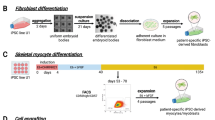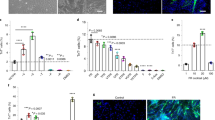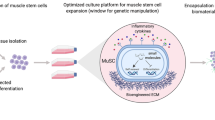Abstract
We have tested the feasibility of muscle-based gene therapy and tissue engineering for urological dysfunction using highly purified muscle-derived cells (MDC) that display stem cell characteristics. We then explored the potential use of these MDC as an alternative therapy for the treatment of impaired detrusor contractility. The MDC were genetically engineered to express the gene encoding β-galactosidase and injected into the bladder walls of SCID mice. The injected bladders were harvested at various time-points after injection and assayed for β-galactosidase activity; the presence of myofibers within the injected tissue was determined by detection of fast myosin heavy chain isoform (MyHCs). We have demonstrated that the injected MDC are capable of not only surviving in the lower urinary tract, but also improving the contractility of the bladder following an induced injury. Two potential mechanisms can be used to explain this finding. First, we have observed that some of the β-galactosidase-expressing cells expressed α-smooth muscle actin, suggesting a differentiation into smooth muscle. Second, a stain for acetylcholine receptors (AChRs), which identifies the location of neuromuscular junctions, revealed that the myofibers derived from the doner cells became innervated into the bladder as early as 2 weeks after injection. These results suggest that gene therapy and tissue engineering based on MDC potentially can be used for urological dysfunction.
This is a preview of subscription content, access via your institution
Access options
Subscribe to this journal
Receive 12 print issues and online access
$259.00 per year
only $21.58 per issue
Buy this article
- Purchase on Springer Link
- Instant access to full article PDF
Prices may be subject to local taxes which are calculated during checkout






Similar content being viewed by others
References
Agency for Health Care Policy and Research. Public Health Service: Urinary Incontinence, Public Information, US Department of Health and Human Services. December 1996.
Gelber DA, Good DC, Laven LJ, Verhulst SJ . Causes of urinary incontinence after acute hemispheric stroke Stroke 1993 24: 378–382
Gelber DA, Good DC, Laven LJ, Verhulst SJ . Causes of urinary incontinence after acute hemispheric stroke Chancellor MB, Blaivas JG. Atlas of Urodynamics. Williams and Wilkins: Philadelphia, 1996.
Nakayama H et al. Prevalence and risk factors of incontinence after stroke. The Copenhagen Stroke Study Stroke 1997 28: 58–62
Wein AJ, Raezer D, Malloy T . Failure of the bethanechol supersensitivity test to predict improved voiding after subcutaneous bethanechol administration J Urol 1980 123: 302
Wein AJ . Pharmacology of incontinence Urol Clin North Am 1995 22: 557–577
Gussoni E et al. Dystrophin expression in the mdx mouse restored by stem cell transplantation Nature 1999 401: 390–394
Musgrave DM, Huard J . Muscle-based tissue engineering for the musculoskeletal system Gene Ther Mol Bio 1999 3: 207–221
Lee JY et al. Clonal isolation of muscle-derived cells capable of enhancing muscle regeneration and bone healing J Cell Biol 2000 150: 1085–1099
Martinek V, Fu FH, Huard J . Gene therapy and tissue engineering in sports medicine Phys Sports Med 2000 28: 34–51
Partridge TA et al. Conversion of mdx myofibers from dystrophin negative to positive by injection of normal myoblasts Nature 1989 337: 176–179
Karpati G et al. Myoblast transfer in Duchenne muscular dystrophy Ann Neurol 1993 34: 8–17
Tremblay JP et al. Results of a blind clinical study of myoblast transplantation without immunosuppressive treatment in young boys with DMD Cell Transplantation 1993 2: 99–112
Beauchamp JR, Morgan JE, Pagel CN, Partridge TA . Quantitative studies of efficacy of myoblast transplantation Muscle Nerve 1994 18: S261
Huard J et al. Gene transfer into skeletal muscles by isogenic myoblasts Hum Gene Ther 1994 5: 949–958
Huard J et al. High efficiency of muscle regeneration following human myoblast clone transplantation in SCID mice J Clin Invest 1994 93: 586–599
Mendell JR et al. Myoblast transfer in the treatment of Duchenne's muscular dystrophy New Engl J Med 1995 333: 832–838
Fan Y, Maley M, Beilharz M, Grounds M . Rapid death of injected myoblasts in myoblast transfer therapy Muscle Nerve 1996 19: 853–860
Gussoni E, Blau HM, Kunkel LM . The fate of individual myoblasts after transplantation into muscles of DMD patients Nat Med 1997 3: 970–977
Qu Z et al. Development of approaches to improve cell survival in myoblast transfer therapy J Cell Biol 1998 142: 1257–1267
Richler C, Yaffe D . The in vitro cultivation and differentiation capacities of myogenic cell lines Dev Biol 1970 23: 1–22
Rando TA, Blau HM . Primary mouse myoblast purification, characterization, and transplantation for cell-mediated gene therapy J Cell Biol 1994 125: 1275–1287
Beauchamp JR, Morgan JE, Pagel CN, Partridge TA . Dynamics of myoblast transplantation reveal a discrete minority of precursors with stem cell-like properties as the myogenic source J Cell Biol 1999 144: 1113–1122
Katagiri T et al. Bone morphogenetic protein-2 converts the differentiation pathway of C2C12 myoblasts into the osteoblast lineage J Cell Biol 1995 127: 1755–1766
Baroffio A et al. Identification of self-renewing myoblasts in the progeny of single human muscle satellite cells Differentiation 1996 60: 47–57
Cornelison DD, Wold BJ . Single-cell analysis of regulatory gene expression in quiescent and activated mouse skeletal muscle satellite cells Dev Biol 1997 191: 270–283
Miller JB, Schaefer L, Dominov JA . Seeking muscle stem cells Curr Top Dev Biol 1999 43: 191–219
Jackson KA, Mi T, Goodell MA . Hematopoietic potential of stem cells isolated from murine skeletal muscle Proc Natl Acad Sci USA 1999 96: 14482–14486
Bosch P et al. Osteoprogenitor cells within skeletal muscle J Orthop Res 2000 18: 933–944
McHugh KM . Molecular analysis of smooth muscle development in the mouse Dev Dyn 1995 204: 278–290
Darby I, Skalli O, Gabbiani G . Alpha-smooth muscle actin is transiently expressed by myofibroblasts during experimental wound healing Lab Invest 1990 63: 21–29
Shimizu T, Matsumura K, Sunada Y, Mannen T . Dense immunostaining on both neuromuscular and myotendon junctions with an antidystrophin antibody Biomed Res 1989 10: 405–409
Shortliffe LM et al. Treatment of urinary incontinence by the periurethral implantation of glutaraldehyde cross-linked collagen J Urol 1989 141: 538–541
McGuire EJ, Appell R . Transurethral collagen injection for urinary incontinence Urology 1994 43: 413–415
Frey P, Berger D, Jenny P, Herzog B . Suburethral collagen injection for the endoscopic treatment of vesicoureteral reflux in children: follow-up study of 97 treated ureters and histological analysis of collagen implants J Urol 1992 148: 718–723
Herschorn S, Steele DJ, Radomski SB . Follow up of intraurethral collagen for female stress urinary incontinence J Urol 1996 156: 1305–1309
Yokoyama T et al. Persistence and survival of autologous muscle-derived cells versus bovine collagen as a potential treatment of stress urinary incontinence J Urol 2001 165: 271–276
Shimizu RT et al. The smooth muscle α-actin gene promoter is differentially regulated in smooth muscle versus non-smooth muscle cells J Biol Chem 1995 270: 7631–7643
Gibson AJ . Dermal fibroblasts convert to a myogenic lineage in mdx mouse muscle J Cell Sci 1995 108: 207–214
Gibson AJ . Dermal fibroblasts convert to a myogenic lineage in mdx mouse muscle Li Y, Huard J. Differentiation of muscle-derived cells into myofibroblasts in injured skeletal muscle. Am J Pathol 2002 (in press).
Qu-Petersen Z et al. Identification of a novel population of muscle stem cells in mice: potential for muscle regeneration J Cell Biol 2002 157: 851–864
Floyd SS et al. Ex vivo gene transfer using adenovirus-mediated full-length dystrophin delivery to dystrophic muscles Gene Therapy 1998 5: 19–30
Yuasa K et al. Effective restoration of dystrophin associated proteins in vivo by adenovirus-mediated transfer of truncated dystrophin cDNAs FEBS Lett 1998 425: 329–336
Yuasa K et al. Effective restoration of dystrophin associated proteins in vivo by adenovirus-mediated transfer of truncated dystrophin cDNAs Sambrook J, Fritsch EF, Maniatis T. Molecular Cloning. A Laboratory Manual. Cold Spring Harbar Laboratory Press: Plainview, NY, 1989, pp 16.66-16.67.
Acknowledgements
The authors wish to acknowledge Marcelle Pellerin, Rudrani Ghosh and Maggie Sistek for their technical and secretarial assistance, respectively, and Ryan Sauder for editorial assistance. The authors wish also to acknowledge the critical comments made by Mr Ron J Jankowski and Dr Shing-Hwa Lu. This work was supported by William F and Jean W Donaldson Chair, NIDDK support: NIH RO1 DK55387 and NIH 2R01 DK05538705, and Pittsburgh Tissue Engineering Initiative (PTEI).
Author information
Authors and Affiliations
Rights and permissions
About this article
Cite this article
Huard, J., Yokoyama, T., Pruchnic, R. et al. Muscle-derived cell-mediated ex vivo gene therapy for urological dysfunction. Gene Ther 9, 1617–1626 (2002). https://doi.org/10.1038/sj.gt.3301816
Received:
Accepted:
Published:
Issue Date:
DOI: https://doi.org/10.1038/sj.gt.3301816
Keywords
This article is cited by
-
Stem cell therapy combined with controlled release of growth factors for the treatment of sphincter dysfunction
Cell & Bioscience (2023)
-
Exosome biopotentiated hydrogel restores damaged skeletal muscle in a porcine model of stress urinary incontinence
npj Regenerative Medicine (2022)
-
Generation of myogenic progenitor cell-derived smooth muscle cells for sphincter regeneration
Stem Cell Research & Therapy (2020)
-
Current and Future Directions of Stem Cell Therapy for Bladder Dysfunction
Stem Cell Reviews and Reports (2020)
-
Harnessing the mesenchymal stem cell secretome for regenerative urology
Nature Reviews Urology (2019)



